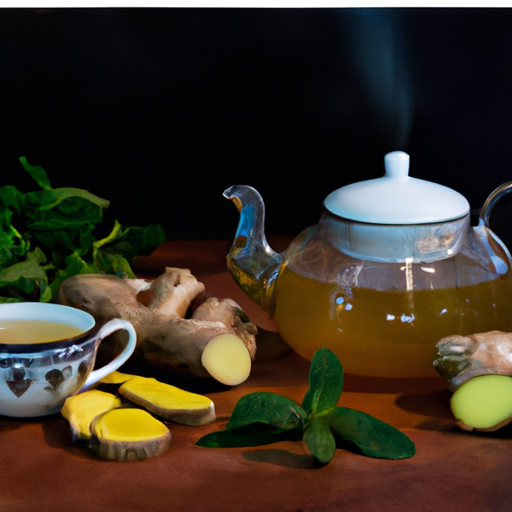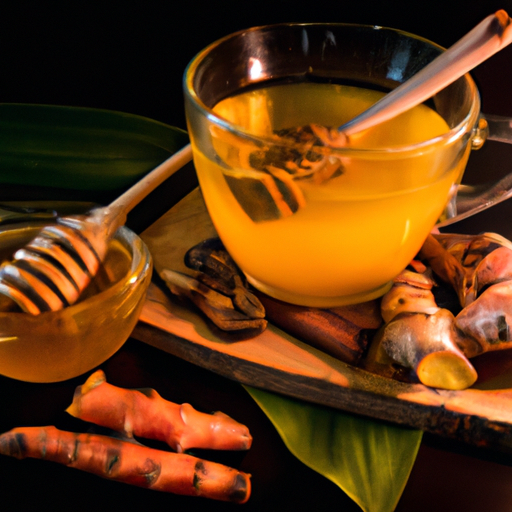I absolutely adore beginning my day with a hot mug of fresh ginger and turmeric tea. It’s not just tasty, but it’s also packed with health advantages that make it an ideal choice for anyone’s morning regimen.
Ginger and turmeric are both known for their anti-inflammatory properties, which can help reduce pain and inflammation in the body.
To make this tea, all you need is fresh ginger root, fresh turmeric root, water, and a little bit of honey or lemon juice if desired. It’s incredibly easy to prepare and brew, making it a great option for those who want to incorporate more natural remedies into their daily routine.
In this article, I’ll be sharing my go-to recipe for fresh ginger and turmeric tea as well as some tips on how to get the most out of your cup. So grab your ingredients and let’s get started!
Key Takeaways
- Fresh ginger and turmeric tea has many health benefits, including anti-inflammatory properties and potential cancer-fighting effects.
- The tea is easy to prepare by grating fresh ginger and turmeric and simmering in boiling water for 10-15 minutes.
- Lemon and honey can be added for flavor and extra health benefits.
- Health precautions should be taken when consuming ginger and turmeric tea, including starting with small amounts and being aware of potential side effects.
The Health Benefits of Ginger and Turmeric Tea
You’re in for a treat with this tea, not only because it’s delicious, but also because the combination of ginger and turmeric offers a plethora of health benefits that you won’t want to miss out on.
Ginger has long been known for its anti-inflammatory properties, which can help to reduce pain and swelling throughout the body. Turmeric is also an inflammation-fighting powerhouse thanks to its high concentration of curcumin.
In addition to reducing inflammation, these two ingredients may also have potential cancer-fighting effects. Studies have shown that both ginger and turmeric contain compounds that can help to prevent the growth and spread of cancer cells. While more research is needed in this area, incorporating these spices into your diet certainly isn’t going to hurt.
So if you’re looking for a simple way to boost your overall health and wellness, try adding fresh ginger and turmeric tea into your routine. Not only will it taste great, but it could potentially provide some serious benefits as well!
Now let’s move onto the next section where we’ll discuss the ingredients needed to make this delicious tea.
Ingredients Needed to Make Fresh Ginger and Turmeric Tea
To brew this fragrant beverage, all you need are a few simple ingredients that can be easily found in your pantry or local grocery store. The two main ingredients needed to make fresh ginger and turmeric tea are ginger and turmeric.
Ginger is known for its anti-inflammatory properties and has been used in traditional medicine for centuries. Turmeric, on the other hand, contains curcumin which also has anti-inflammatory effects.
Apart from ginger and turmeric, you’ll also need water and sweetener (optional). Some people prefer their tea unsweetened while others add honey or maple syrup to enhance its taste. It’s important to note that too much of anything is never good so use sweeteners moderately.
Additionally, it’s worth noting that some individuals might experience side effects after consuming large amounts of ginger or turmeric. Therefore, it’s essential to talk to your doctor before adding them into your diet.
In terms of culinary uses, both ginger and turmeric are common spices used in cooking various dishes worldwide. However, drinking them as tea allows you to enjoy their health benefits more directly because they’re not diluted by other ingredients like salt or oil.
Now that we’ve gone through the necessary ingredients, let’s move on to how we prepare our fresh ginger and turmeric tea!
How to Prepare the Ginger and Turmeric
Start by grabbing a sharp knife and peeling the ginger, revealing its yellow flesh and spicy aroma. Next, grab a grater and grate the ginger into small pieces. You can also use a microplane if you want your tea to be less chunky.
Grating the ginger will help release its flavor and make it easier to mix in with the turmeric. When preparing turmeric, start by rinsing it under cold water to remove any dirt or debris. Then, peel off the skin using a vegetable peeler or spoon.
Turmeric can stain your hands and clothing easily, so be careful while handling it. Once peeled, grate the turmeric using the same grater as used for ginger. Different grating techniques can alter your flavor profile significantly – finer shreds will distribute more evenly throughout your tea while larger chunks may give you bigger bursts of flavor.
Experiment with different sizes until you find what works best for you! Now that your ingredients are ready, let’s move on to brewing some delicious fresh ginger and turmeric tea.
Without further ado, let’s dive into making our fresh ginger and turmeric tea!
How to Brew the Tea
So now that we’ve got our fresh ginger and turmeric prepared, let’s move on to brewing the tea.
First, I bring a pot of water to a boil, then add in the grated ginger and turmeric.
I let it simmer for about 10-15 minutes before straining out the solids.
For added flavor and health benefits, I like to finish off my tea by adding a squeeze of lemon and some honey.
Boiling Water
First, let’s heat up some water until it reaches boiling point. The type of tea leaves you use will determine how hot the water should be. For example, black and herbal teas require boiling water while green and white teas should be brewed with water that is slightly below boiling point. Adding ginger and turmeric to the tea can also affect the temperature at which it should be brewed.
Infusing other herbs and spices into the tea can also impact its flavor profile, but make sure they’re added in moderation to avoid overpowering the taste of ginger and turmeric.
Once you’ve chosen your preferred tea leaves and any additional herbs or spices, bring a pot of fresh water to a boil on your stovetop or using an electric kettle. When the water’s reached boiling point, turn off the heat source and allow it to cool for a few minutes before adding in your ginger and turmeric slices.
Adding the Ginger and Turmeric
As we’re all sophisticated tea drinkers here, let’s spice things up by tossing in some of our favorite root vegetables to infuse our cups with their unique flavors. Adding ginger and turmeric to your tea not only adds a delicious kick but also provides numerous health benefits. Ginger has been used for centuries as a natural remedy for nausea, inflammation, and digestive issues. Turmeric, on the other hand, is known for its anti-inflammatory properties and is often used in Indian cuisine.
To make the perfect ginger and turmeric tea, start by adding peeled and sliced ginger and turmeric roots into a pot of boiling water. Let them simmer together for about 10-15 minutes to allow the flavors to blend together. You can adjust the amount of ginger and turmeric depending on your preference – more roots mean stronger flavor!
As you wait for your tea to brew, you may be wondering what else you can do with these wonderful ingredients in your cooking. Ginger can be added to stir-fries or soups for an extra zingy taste while turmeric is commonly found in curry dishes or even smoothies. Now that we’ve infused our tea with these amazing roots, it’s time to add some lemon juice and honey for that extra burst of flavor!
Adding Lemon and Honey
Now that we’ve added the ginger and turmeric to our tea, let’s take it up a notch by adding some lemon and honey. Lemon is not only a great flavor enhancer but also has several health benefits. It contains vitamin C, which boosts our immune system, aids in digestion, and helps detoxify the body.
On the other hand, honey is a natural sweetener with anti-inflammatory properties that can soothe sore throats and coughs. To make this tea even more delicious and beneficial for our health, here are some different types of honey you can try:
- Manuka Honey – This type of honey comes from New Zealand and has antibacterial properties that can help fight infections.
- Acacia Honey – This light-colored honey has a mild taste and low glycemic index, making it suitable for people with diabetes.
- Buckwheat Honey – This dark-colored honey has a strong flavor profile and high antioxidant content.
- Wildflower Honey – As the name suggests, this type of honey comes from different flowers present in nature and has various nutritional benefits.
Adding lemon and honey to your ginger and turmeric tea not only enhances its taste but also provides numerous health benefits. Now let’s move on to some tips for making a perfect cup of ginger and turmeric tea without compromising its flavors or nutrients.
Tips for a Perfect Cup of Ginger and Turmeric Tea
When I make ginger and turmeric tea, there are a few key factors that contribute to a perfect cup. Firstly, using fresh ingredients is crucial for the best flavor and health benefits.
Secondly, steeping time should be carefully monitored to avoid bitterness or lack of flavor.
Lastly, adjusting the flavors with honey or lemon can enhance the taste and add extra health benefits.
By following these tips, you can ensure a delicious and nutritious cup of ginger and turmeric tea every time.
Using Fresh Ingredients
To use fresh ingredients, simply peel and slice the ginger and turmeric into thin pieces before adding them to boiling water. Using fresh ingredients has multiple benefits when it comes to cooking and brewing tea. Fresh ginger and turmeric are packed with nutrients, antioxidants, and anti-inflammatory properties that can help boost your immune system, reduce inflammation in the body, improve digestion, and alleviate pain.
When selecting high quality ginger and turmeric for your tea, look for firm roots with smooth skin that are free of blemishes or wrinkles. The aroma should be strong and pungent – a sign of freshness. To store fresh ginger and turmeric, keep them in a cool, dry place or in the refrigerator wrapped in paper towels to absorb excess moisture.
Now that you’ve added your fresh ingredients to boiling water, it’s important to let them steep for the right amount of time to get the best flavor and health benefits from your tea.
Steeping Time
Steeping your tea for the right amount of time is like waiting for a flower to bloom – it takes patience and attention to detail. Here are some tips on how to get the perfect cup of ginger and turmeric tea using proper steeping techniques:
-
Boil water in a kettle or pot, and pour it over the ginger and turmeric slices in a teapot.
-
Let the mixture steep for at least 5 minutes to allow the flavors to infuse into the water.
-
For a stronger flavor, you can steep for up to 10 minutes, but be careful not to over-steep as this can result in a bitter taste.
-
If you prefer a milder taste, you can reduce the steeping time or adjust the ratio of ginger and turmeric.
By following these guidelines, you’ll be able to enjoy a perfectly brewed cup of fresh ginger and turmeric tea every time.
In the next section, we’ll explore how you can customize your tea’s flavor by adjusting its ingredients.
Adjusting the Flavors
Customizing the flavor of your cuppa is easy and fun, as you can play around with different ingredients to create a unique taste that suits your palate. One way to adjust the flavor is by adjusting the sweetness. If you prefer a sweeter tea, add honey or maple syrup to taste. Alternatively, if you want a less sweet brew, try using less sweetener or omitting it altogether.
Another way to experiment with the flavors of ginger and turmeric tea is by playing with the spice levels. If you like things hot and spicy, add more fresh ginger or even some cayenne pepper to give your tea an extra kick. On the other hand, if you prefer a milder flavor profile, start with just a small amount of ginger and turmeric and work your way up until you find what works best for you.
Ultimately, there are endless possibilities when it comes to customizing your cuppa, so don’t be afraid to get creative! For those who are looking for even more ways to switch up their ginger and turmeric tea routine, there are plenty of variations to try such as adding lemon juice or swapping out honey for agave nectar.
Keep reading for more ideas on how to keep things interesting in your daily cuppa!
Variations to Try
Now that I’ve mastered the art of making fresh ginger and turmeric tea, I’m excited to explore some variations.
One option is adding cinnamon or black pepper to the mix for added flavor and health benefits.
Another idea is to experiment with different types of honey, like manuka or wildflower, which can change the taste and medicinal properties of the tea.
Let’s dive into these options and see what delicious combinations we can come up with!
Adding Cinnamon or Black Pepper
If you want to give your ginger and turmeric tea an extra kick, sprinkle some cinnamon or black pepper in it for a spicy twist! Not only will it add some flavor variety, but these spices come with their own set of health benefits.
Firstly, cinnamon has been shown to have anti-inflammatory properties and can help regulate blood sugar levels. It also contains antioxidants which can protect the body from damage caused by free radicals.
Black pepper, on the other hand, is known to aid in digestion and improve gut health. It also contains piperine which enhances the absorption of curcumin found in turmeric.
To incorporate these spices into your tea, try adding a pinch of cinnamon or a few cracks of freshly ground black pepper before letting your tea steep.
Now that we’ve talked about spicing up our ginger and turmeric tea with cinnamon or black pepper, let’s move on to exploring different types of honey as a sweetener option.
Using Different Types of Honey
Using different types of honey can add unique flavors to your brew and provide additional health benefits. There are two main types of honey: floral and fruity. Floral honeys, such as lavender or clover honey, have a lighter taste and pair well with light teas like green tea. Fruity honeys, such as orange blossom or blueberry honey, have a stronger flavor that pairs well with bold teas like black tea.
Another factor to consider is whether the honey is raw or processed. Raw honey is unfiltered and unpasteurized, which means it retains its natural enzymes and nutrients. Processed honey has been heated and filtered, which removes some of its beneficial properties. When using honey in other tea recipes, try mixing chamomile tea with raw honey for a soothing bedtime drink or adding a drizzle of fruity honey to green tea for a burst of flavor.
Now that we’ve explored the various ways to enhance your ginger and turmeric tea with spices and sweeteners, it’s important to note some health precautions when consuming these ingredients regularly.
Health Precautions
To stay healthy while making fresh ginger and turmeric tea, remember to wash your hands before handling the ingredients. This is important because you don’t want to introduce any harmful bacteria into the tea.
Additionally, make sure that all utensils and equipment used in the preparation of the tea are clean.
Precautions should also be taken when consuming ginger and turmeric tea as they may have some side effects. These include stomach upset, heartburn, and diarrhea in some individuals. It’s important to start with small amounts of ginger and turmeric if you’re not used to consuming them regularly, or if you have a sensitive stomach.
If you experience any adverse reactions after drinking ginger and turmeric tea, stop consuming it immediately. Consult a healthcare professional if symptoms persist or worsen over time.
With these precautions in mind, you can safely enjoy the health benefits of this delicious beverage.
When storing and reheating ginger and turmeric tea, it’s important to do so properly in order to maintain its freshness and flavor.
Storing and Reheating Ginger and Turmeric Tea
To keep your ginger and turmeric tea fresh and flavorful, proper storage and reheating techniques are essential. The best containers for storing this type of tea are airtight glass jars or bottles. Avoid using plastic containers as they can leach harmful chemicals into the tea over time.
Store the ginger and turmeric tea in a cool, dry place away from direct sunlight to avoid spoilage. When reheating stored ginger and turmeric tea, it’s important not to boil the mixture again as this will affect the taste and nutritional value of the tea. Instead, gently heat it on the stove or in the microwave until warm.
If you prefer cold ginger and turmeric tea, you can try cold brewing options by soaking fresh ginger root and turmeric powder or grated turmeric root in water overnight in the fridge. It’s also important to note that stored ginger and turmeric tea has a shelf life of about 3-4 days when refrigerated properly.
If you want to store them for longer periods, freezing them in ice cube trays is an alternative storage option. Simply pop one or two cubes into hot water whenever you need a cup of fresh ginger and turmeric tea. In the next section, I’ll discuss other uses for ginger and turmeric beyond making a simple cup of tea.
Other Uses for Ginger and Turmeric
Beyond their use in tea, ginger and turmeric offer a myriad of health benefits and can be incorporated into various recipes to add flavor and nutrition. Ginger has anti-inflammatory properties that can help alleviate pain and reduce the risk of chronic diseases such as heart disease, diabetes, and cancer.
Turmeric contains curcumin, which is known for its antioxidant properties that can protect against oxidative damage caused by free radicals. Using ginger and turmeric in cooking is an easy way to incorporate these spices into your diet.
You can add grated or minced ginger to stir-fries, soups, marinades, dressings, and baked goods for a spicy kick. Turmeric can be used in curry dishes, rice dishes, roasted vegetables, smoothies, and even desserts like golden milk ice cream. The benefits of incorporating ginger and turmeric into your diet are numerous.
They’ve been shown to improve digestion, boost immunity, lower inflammation levels in the body, improve brain function and mood, regulate blood sugar levels, lower cholesterol levels, and blood pressure. Adding these spices to your meals not only enhances the flavor but also provides a range of health benefits that can help you feel better both physically and mentally.
Frequently Asked Questions
Can ginger and turmeric tea be made with dried ingredients instead of fresh?
I was just thinking about substituting dried ingredients for fresh ones in my ginger and turmeric tea recipe, and it turns out that it’s actually possible!
While fresh ingredients are always preferred, using dried ginger and turmeric can still provide you with some health benefits. Dried ginger has been shown to help with digestion, reduce inflammation, and even alleviate nausea. Similarly, dried turmeric contains curcumin, which has been linked to reducing the risk of chronic diseases such as cancer and Alzheimer’s.
So go ahead and try making your tea with dried ingredients if you don’t have access to fresh ones – you’ll still be doing something good for your body!
How much ginger and turmeric should be used to make a single cup of tea?
When making a single cup of ginger and turmeric tea, I typically use about 1 inch of fresh ginger root and 1 teaspoon of fresh turmeric root. However, the amount can vary depending on personal preference and desired strength of flavor.
It’s important to note that both ginger and turmeric have numerous health benefits, such as reducing inflammation and aiding in digestion. Incorporating these ingredients into your daily routine can be a great way to support overall health and wellbeing.
Can honey or other sweeteners be added to the tea?
Let me start with a little story about my morning routine. Every day, I wake up feeling like a bear coming out of hibernation, sluggish and sleepy. But as soon as I sip on my freshly brewed ginger and turmeric tea, everything changes. It’s like the sun has risen inside me!
Now, to answer your question: yes, honey or other sweeteners can be added to the tea. In fact, there are many sweetener options available that not only enhance the taste but also offer health benefits. For example, raw honey is known for its antibacterial properties and is an excellent source of antioxidants. Similarly, maple syrup contains minerals like calcium and potassium that promote healthy bones and muscles.
Just make sure to keep your portion sizes in check since excessive sugar consumption can have adverse effects on your health.
Is it safe to drink ginger and turmeric tea while pregnant or breastfeeding?
As a healthcare professional, I understand that ginger and turmeric tea have numerous health benefits, including reducing inflammation and improving digestion. However, it’s essential to consider the potential risks of consuming these teas during pregnancy or breastfeeding.
While there’s limited research on the effects of ginger and turmeric on pregnant women and infants, some studies suggest that high doses may increase the risk of miscarriage or preterm labor. Therefore, it’s best to consult with a healthcare provider before drinking ginger and turmeric tea while pregnant or breastfeeding to ensure its safety for both mother and baby.
Can the leftover ginger and turmeric be used in other recipes or should it be discarded?
As someone who loves to explore ways to minimize food waste, I always prioritize finding ways to reuse leftover ingredients. When it comes to ginger and turmeric, there are plenty of options for incorporating them into other recipes.
Ginger can add a zingy kick to stir-fries, soups, and even baked goods like gingerbread cookies. Turmeric is equally versatile and can be used in curries, smoothies, and even as a natural food coloring agent.
Aside from their culinary uses, both ginger and turmeric offer numerous health benefits that make them worth incorporating into your diet whenever possible. Ginger has been shown to alleviate nausea, reduce inflammation, and improve digestion while turmeric boasts powerful antioxidant properties that may help protect against chronic diseases such as cancer and Alzheimer’s disease.
So don’t let those leftover roots go to waste! Get creative in the kitchen and enjoy all the flavorful and nutritious benefits they have to offer.
Conclusion
So there you have it, my friends! Making fresh ginger and turmeric tea isn’t just easy, it’s also incredibly beneficial to your health.
This powerful drink has been used for centuries as a natural remedy for various ailments, and the science behind its healing properties continues to be explored. As you sip on your warm cup of ginger and turmeric tea, imagine the anti-inflammatory compounds coursing through your body, reducing inflammation and boosting your immune system.
Picture the antioxidants neutralizing harmful free radicals in your cells, promoting healthy aging. And don’t forget about the delightful flavor that this tea brings – a comforting blend of spicy ginger and earthy turmeric that will leave you feeling rejuvenated.
So go ahead, give this recipe a try and see how it can benefit both your mind and body. Cheers to good health!










